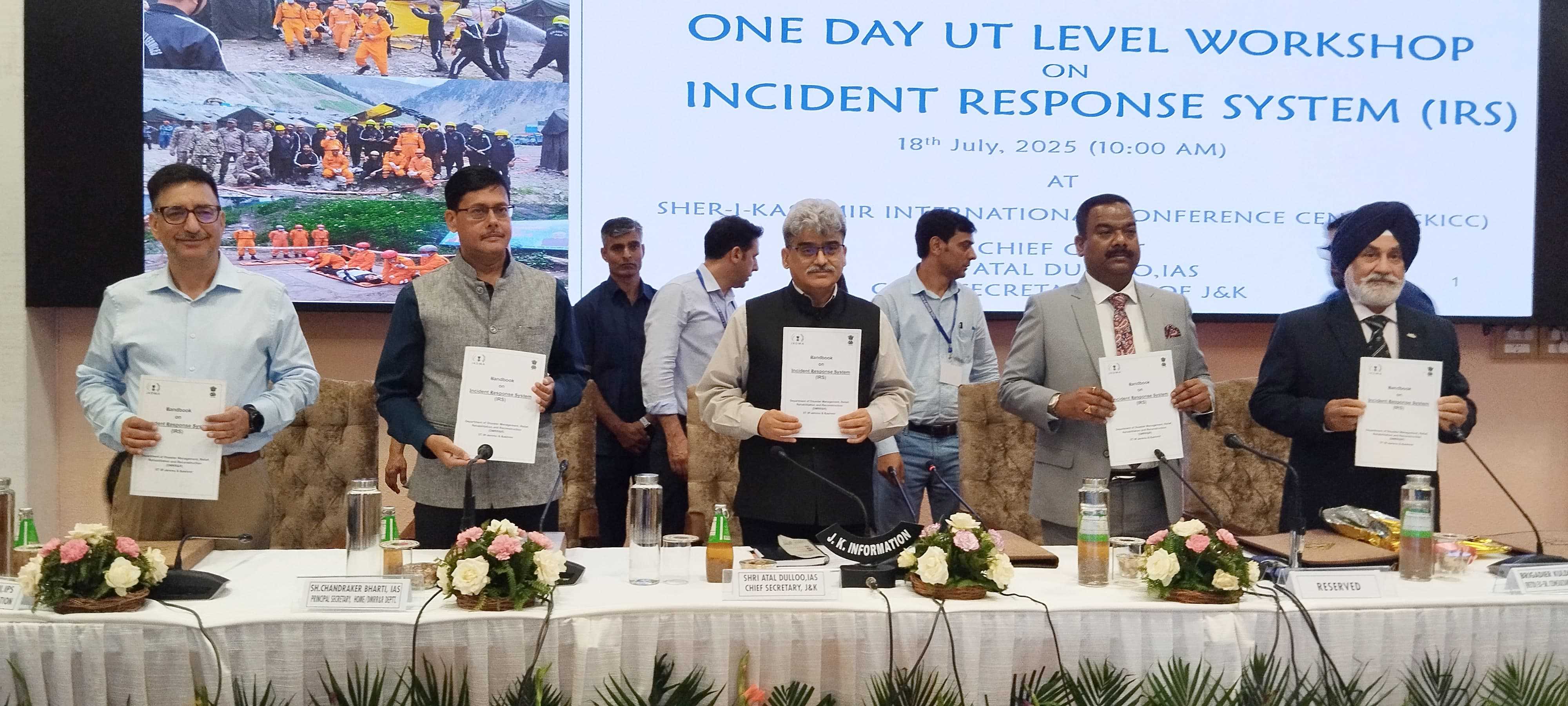
Launches IRS handbook
In a significant move to strengthen disaster preparedness and resilience, the Union Territory of Jammu and Kashmir today conducted a high-level workshop on the Incident Response System (IRS). The event brought together senior officials, experts, and stakeholders from across the UT to institutionalize a structured response mechanism for emergencies.
The workshop was attended by Chief Secretary Atal Dulloo, Principal Secretary Home and DMRR&R Chandraker Bharti, senior administrative secretaries, divisional commissioners, heads of departments, and national disaster management experts including Brigadier Kuldip Singh (Retd), former senior consultant to the Ministry of Home Affairs.
In his opening address, Chief Secretary Dulloo stressed the urgency of building a culture of preparedness at all levels of society. “Disasters arrive unannounced. Citizens are always the first responders,” he said, emphasizing that effective preparedness requires public awareness, institutional strength, and technological adoption.
Dulloo highlighted J&K's heightened vulnerability to earthquakes, landslides, glacial lake outburst floods (GLOFs), and cross-border tensions, noting that rising urbanization and climate change have further intensified these risks. He called for localized IRS protocols, integration of technologies like GIS mapping, real-time weather alerts, drones, and regular mock drills for better preparedness.
He proposed the development of a Disaster Dashboard to map critical resources and high-risk zones across the UT and urged institutional integration of disaster management training for officers.
In his inaugural remarks, Principal Secretary Chandraker Bharti explained that the IRS system, recently notified in J&K, offers a clear command structure during disasters based on national and international best practices. He elaborated on ongoing initiatives like GLOF and landslide mitigation plans, the India Disaster Resource Network (IDRN), and the setting up of a UT-level Emergency Operations Center (EOC).
Disaster expert Brigadier Kuldip Singh (Retd) delivered a presentation on standard operating procedures (SOPs), risk categorization, and the roles of central and local agencies. He emphasized that disaster response must be community-based, resource-efficient, and scalable.
The highlight of the workshop was the launch of the Incident Response System Handbook, which outlines the hierarchical structure and defined responsibilities of officers at all levels—from the Chief Secretary as Response Officer to designated Incident Commanders and liaison officials. The handbook institutionalizes a robust disaster management mechanism in the UT.
The event marked a critical step toward making Jammu and Kashmir a model of disaster resilience, through strategic planning, inter-agency coordination, and active public engagement.
Launches IRS handbook
In a significant move to strengthen disaster preparedness and resilience, the Union Territory of Jammu and Kashmir today conducted a high-level workshop on the Incident Response System (IRS). The event brought together senior officials, experts, and stakeholders from across the UT to institutionalize a structured response mechanism for emergencies.
The workshop was attended by Chief Secretary Atal Dulloo, Principal Secretary Home and DMRR&R Chandraker Bharti, senior administrative secretaries, divisional commissioners, heads of departments, and national disaster management experts including Brigadier Kuldip Singh (Retd), former senior consultant to the Ministry of Home Affairs.
In his opening address, Chief Secretary Dulloo stressed the urgency of building a culture of preparedness at all levels of society. “Disasters arrive unannounced. Citizens are always the first responders,” he said, emphasizing that effective preparedness requires public awareness, institutional strength, and technological adoption.
Dulloo highlighted J&K's heightened vulnerability to earthquakes, landslides, glacial lake outburst floods (GLOFs), and cross-border tensions, noting that rising urbanization and climate change have further intensified these risks. He called for localized IRS protocols, integration of technologies like GIS mapping, real-time weather alerts, drones, and regular mock drills for better preparedness.
He proposed the development of a Disaster Dashboard to map critical resources and high-risk zones across the UT and urged institutional integration of disaster management training for officers.
In his inaugural remarks, Principal Secretary Chandraker Bharti explained that the IRS system, recently notified in J&K, offers a clear command structure during disasters based on national and international best practices. He elaborated on ongoing initiatives like GLOF and landslide mitigation plans, the India Disaster Resource Network (IDRN), and the setting up of a UT-level Emergency Operations Center (EOC).
Disaster expert Brigadier Kuldip Singh (Retd) delivered a presentation on standard operating procedures (SOPs), risk categorization, and the roles of central and local agencies. He emphasized that disaster response must be community-based, resource-efficient, and scalable.
The highlight of the workshop was the launch of the Incident Response System Handbook, which outlines the hierarchical structure and defined responsibilities of officers at all levels—from the Chief Secretary as Response Officer to designated Incident Commanders and liaison officials. The handbook institutionalizes a robust disaster management mechanism in the UT.
The event marked a critical step toward making Jammu and Kashmir a model of disaster resilience, through strategic planning, inter-agency coordination, and active public engagement.
© Copyright 2023 brighterkashmir.com All Rights Reserved. Quantum Technologies